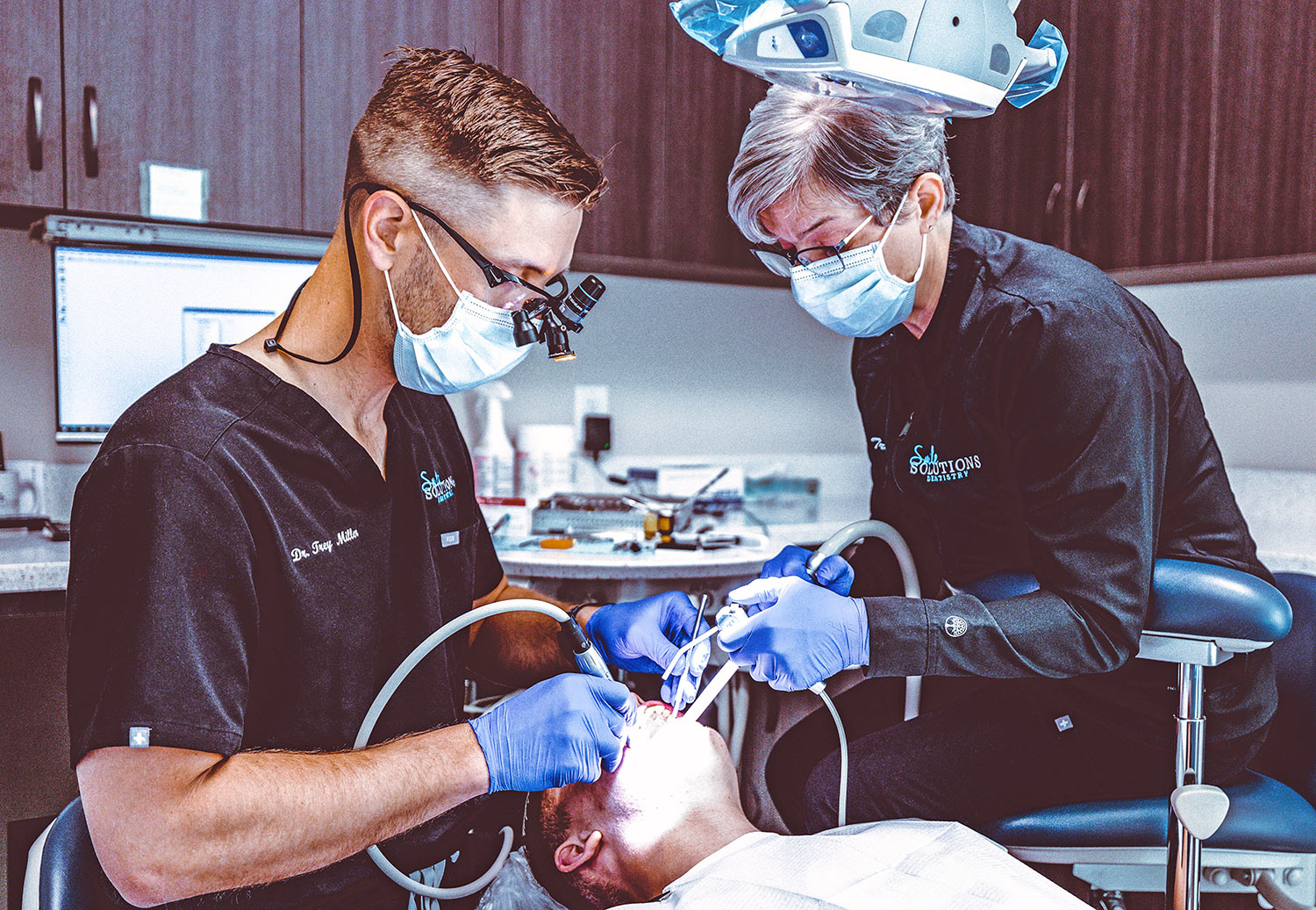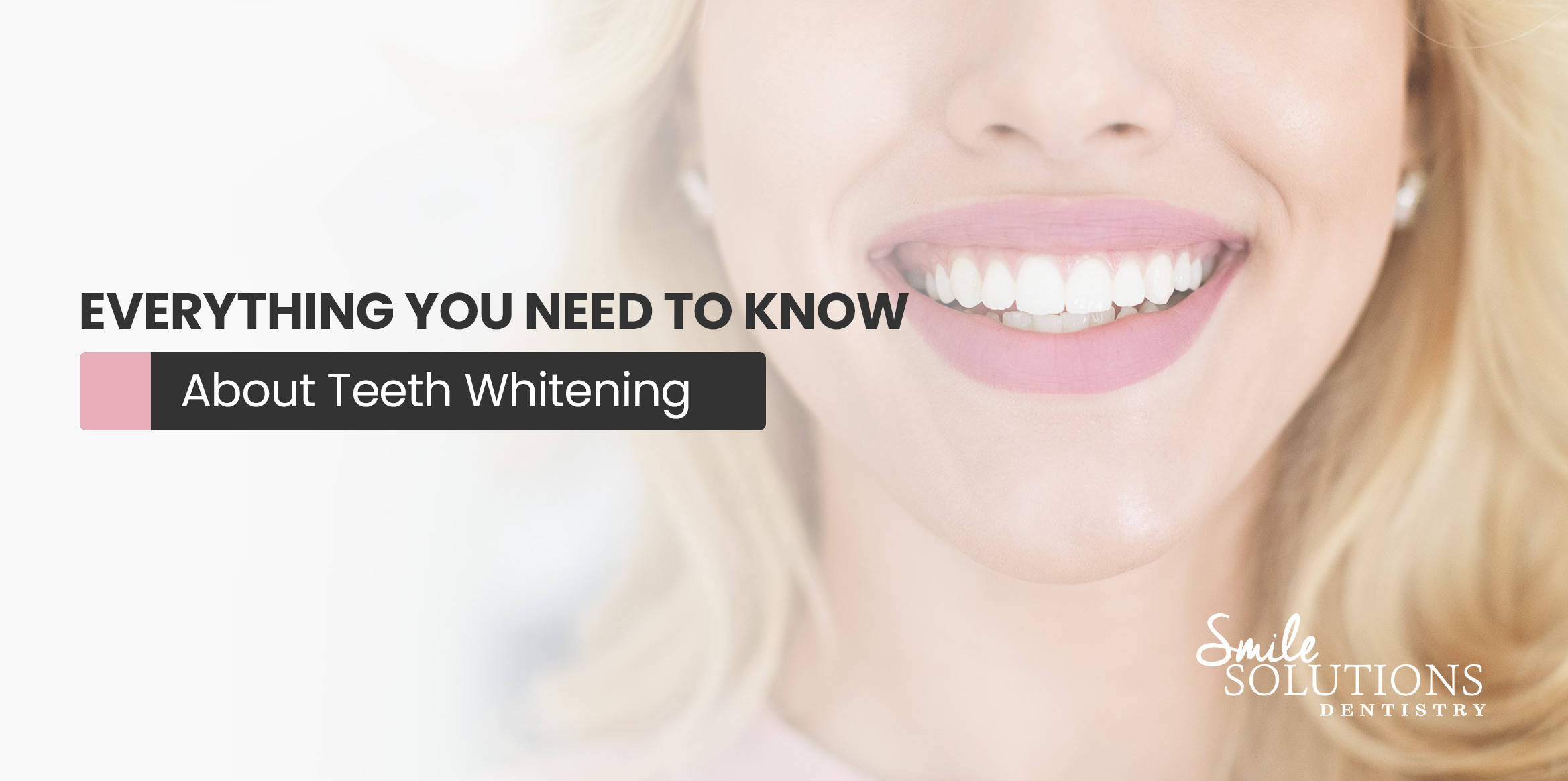Everything You Need to Know About Teeth Whitening
One of the first things people notice is our smile. Because many people strive to have a beautiful smile, teeth whitening is one of the most popular cosmetic dentistry treatments. It is a quick, non-invasive, and affordable way to boost your confidence. But that’s not the only thing to consider when thinking about whitening your teeth. There is cost, lifestyle habits, and whether an in-office whitening or custom take-home-trays is better for you.
But let’s get one thing clear at first. Is teeth whitening actually bleaching or whitening your teeth?
The term whitening refers to restoring a tooth’s surface color by removing debris and dirt. Technically speaking, any product used to clean the tooth’s surface is considered a whitener, such as toothpaste. We use the term bleaching when teeth are whitened beyond their natural color using products that contain peroxide. So cosmetic whitening is essentially bleaching, but the term whitening sounds better, so it’s more frequently used, even for products that contain bleach.
Tooth Discoloration
There are two categories of tooth discoloration: extrinsic and intrinsic.
Extrinsic stains appear on the surface of your tooth due to exposure to staining foods and beverages such as black coffee, black tea, red wine, tobacco, and routine wear and tear. What also affects this type of staining is inappropriate and irregular oral hygiene. Sometimes extrinsic stains your dentist can remove with brushing and prophylactic dental cleaning. For more stubborn stains, the dentist will need to involve more effort and use more invasive methods such as teeth whitening.
Intrinsic stains are those that form on the inner side of your tooth. This type of staining results from trauma, aging, excessive ingestion of fluoride, or exposure to minerals during teeth formation. Even though many thought intrinsic stains are resistant to bleaching, nowadays, cosmetic dentistry experts remove them with supervised take-home teeth whitening that you should maintain for months or even a year. And in case nothing works properly, there are alternative cosmetic solutions to treat intrinsic staining.
What Causes Tooth Staining?
Age
Tooth coloring and your age are directly linked. Over the years, our teeth get darker as a result of wear and tear, but also stain accumulation. When you undergo whitening procedures, teenagers will experience immediate results, while people in their twenties will experience slightly fewer results and may require a little more effort as their teeth begin to show a yellow cast. The yellowish color turns brown by the forties, and more maintenance may be needed. By the fifties, the teeth have absorbed most of the stubborn stains, which can be very difficult, yet not impossible, to remove.
Starting Color
Not everyone has the same teeth coloration. The teeth coloration people are born with ranges from yellow-brownish to greenish-gray. This coloration intensifies over time. As for the bleaching results, yellowish-brown coloration is more responsive to bleaching than greenish-gray.
Translucency & Thinness
These genetic traits become more pronounced with age. All teeth show some translucency. Teeth that are thick and opaque appear lighter in color, show more sparkle, and are more responsive to bleaching. Teeth that are thinner and more transparent have less of the pigment necessary to have them bleached. These teeth are mostly the front teeth. Transparency is the only condition that any form of cosmetic dentistry can’t correct.
Eating Habits
If you’re a person who consumes red wine, coffee, tea, cola, oranges, and carrots habitually, you’re most likely to have stained teeth. These and other deeply-colored beverages and foods have caused considerable staining over the years. On the other hand, acidic foods like citrus fruits and vinegar contribute to enamel erosion. As a result, the surface of your teeth becomes more transparent, and more yellow-colored dentin shows through.
Smoking Habits
Nicotine leaves a deposit on your teeth which slowly soaks into the tooth structure and can cause intrinsic discoloration.
Grinding
Teeth grinding, of which stress is the leading cause, can cause micro-cracking in the teeth and cause the biting edges to darken.
Trauma
Injuries and falls can produce sizable cracks in the teeth in which a larger amount of stains and debris collect. That causes more noticeable staining.
Drugs & Chemicals
If a person uses tetracycline during tooth formation, it can produce dark gray or brown stains. These stains are very difficult to remove. Also, excessive fluoride consumption can cause areas of white mottling and fluorosis, discoloration marked by the appearance of faint white marks on the teeth.
What Are Your Options?
There are a few whitening options available nowadays. Three, to be precise. These three methods rely on varying concentrations of peroxide and application times.
In-office whitening
This method involves the careful and controlled use of high-concentrated peroxide gel. The dentist or a retained technician will firstly clean your teeth with pumice and then apply the peroxide solution to your teeth after he protects your gums with a paint-on rubber dam. The peroxide remains on the teeth for 15 to 20-minute intervals that add up to an hour at most. People that have stubborn staining may need to come back for one or more additional bleaching sessions or may need to continue with a home-use system.
Over-the-counter products
The cheapest and most convenient teeth whitening method is over-the-counter bleaching products. This store-bought whitening kit contains a bleaching gel with a lower peroxide concentration than the professional take-home kits. You apply the gel with a one-size tray, strip, or paint-on applicators. Unlike other custom trays, you can get these trays that may only whiten a few front teeth.
Professionally dispensed take-home kits
In contrast to other cosmetic teeth whitening options, this process takes more time. At the beginning of this procedure, your dentist will take an impression of your teeth and then make you a soft, custom mouth trays. Then it’s all up to you. You put a thin line of professional whitening gel into your tray and wear it overnight or for a while during the day because the gel contains a lower concentration of peroxide. The lower the percentage of peroxide, the longer the gel may safely remain on your teeth. Even though most whitening occurs in the first two weeks, you might need to wear the trays for up to six weeks.
How White Can You Go?
The results of cosmetic teeth whitening procedures are subjective. They vary considerably from person to person. Some people immediately see the results and are delighted with their outcome, while others may be disappointed.
Before you choose which treatment to start, schedule a call and make an appointment with our dentists so they can give you realistic advice and an idea of what results to expect and how long the process can take.
Maintenance
When you have had your chosen cosmetic teeth whitening procedure, you want to maintain the results as long as possible. Dentists recommend you:
• Avoid dark-colored food and beverages for at least a week
• Sip dark-colored beverages with a straw whenever it’s possible
• Brush and floss your teeth after every meal and at bedtime
• Perform at-home whitening once a year
Risks
Even though these treatments are considered safe when done by a professional, there are certain risks that we want to mention and that you should be aware of:
Sensitivity
Whitening your teeth can increase the sensitivity of your teeth to temperature, pressure, and touch because the bleach used during in-office whitening contains the highest peroxide levels, which is most likely to occur during this type of procedure.
Gum irritation
When you use peroxide whiteners, you can experience some degree of gum irritation. Bleach concentration or irregular contact with the trays can cause irritation. This irritation can last for several days until the peroxide concentration is low enough. If the irritation doesn’t go away after a couple of days, you may need emergency dental care, so make sure you let your dentist know all the symptoms you might be feeling.
Technicolor teeth
Any type of dental implants such as dental crowns or veneers doesn’t get affected by bleach as natural teeth do. They maintain their default color while other teeth get whiter. This phenomenon is called technicolor teeth.
Additional Things You Should Consider
Following the listed risks, there are several things dentist Harrisburg wants you to consider before any cosmetic teeth whitening procedure:
• Dentists don’t advise pregnant and nursing women to whiten their teeth as a potential risk of swallowing the bleach can affect the baby or the fetus.
• You will most likely need tooth replacement after bleaching to avoid the technicolor teeth effect.
• The results of whitening procedures aren’t fully seen until about two weeks after bleaching.
• Any dental implants should not be placed for at least two weeks after the whitening because you want to make sure they match your new teeth’ color.
• Recessed gums often show a yellowish surface at the gum line, which is difficult to bleach.
• No amount of bleach will unnaturally whiten your teeth.
Cost of Teeth Whitening
The cost varies from procedure to procedure and from product to product. In-office teeth whitening is the most expensive option, but it does ensure you get the results you’re looking for and ensure the results last longer. On the other end of the coastline, you have over-the-counter products you can find at your local pharmacy or store. Keep in mind the results of these products vary on the price of the kit. If you’re looking for a medium price, the best option for you is professionally dispensed take-home kits.
Final Thoughts
When you decide to have your teeth whitened, you shouldn’t do anything yourself. See your dentist and make sure you’re a good candidate for any type of cosmetic teeth whitening.
Our experienced team will take good care of you.





